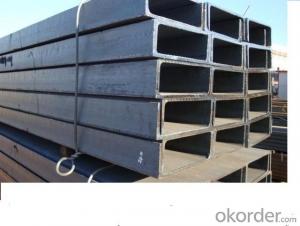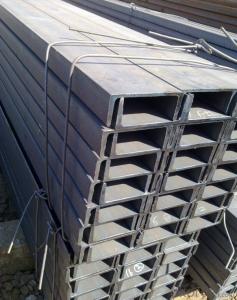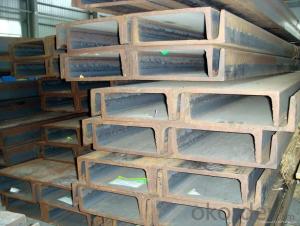GB Standard Steel Channel 300mm with High Quality
- Loading Port:
- China Main Port
- Payment Terms:
- TT or LC
- Min Order Qty:
- 25 m.t
- Supply Capability:
- 10000 m.t/month
OKorder Service Pledge
OKorder Financial Service
You Might Also Like
Product Description:
Specifications of GB Standard Steel Channel 300mm with High Quality:
1. We are definitely specializing in manufacturing and supplying channel steel.
| Standard: | GB/T 6723-86 |
| Material/Grade: | Q235 |
| Sizes: | 300mm |
| Sales Volume/Year: | 3000MT |
| Destination Area: | Middle East, Africa, Southeast Asia |
2.Size, Length and Mass.
| Size(mm) | Length(m) | Mass(Kg/m) |
| 300*85*7.5 mm | 6m, 12m | 34.463 |
| 300*87*9.5mm | 6m, 12m | 39.173 |
| 300*89*11.5mm | 6m, 12m | 43.883 |
Package & Delivery of GB Standard Steel Channel 300mm with High Quality:
The steel u channel will be packed in bundle with steel wire at each end of every bundle and color marking in order to help the customer to recognize his goods more easily at sight.
And steel u channel could be loaded into 20ft or 40ft container, or by bulk cargo. If the weight of each bundle reaches less than 3.5 mt, the loading by break bulk cargo should be choosed. When the weight of each bundle reaches less than 3mt, the loading by container should be choosed.
As for the transportaion from mill to loading port, the truck will be usually used. And the maximum quantity for each truck is 40mt.
All in all, we could do in accordance with customer's request.
FAQ:
Q1: How soon can we receive the product after purchasement?
A1: Within three days of placing an order, we will begin production. The specific shipping date is dependent upon international and government factors, but is typically one month.
Q2: How do you guarantee the quality of our products?
A2: We have established an advanced quality management system which conducts strict quality tests at every step, from raw materials to the final product. At the same time, we provide extensive follow-up service assurances as required.
Q3: The prices are invoicing on theoritical weight or on actual weight?
A3: We can do it in both manners, according to the customers' request.
Images of GB Standard Steel Channel 300mm with High Quality:
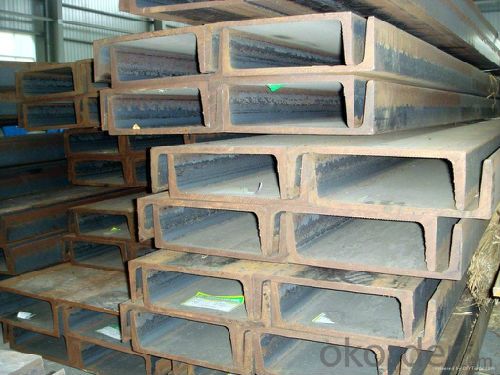
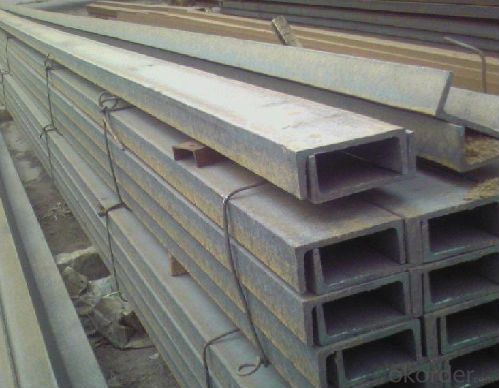
If you would like to get our price, please inform us the standard/material, size and quantity. Thank you very much.
- Q:Can steel channels be used for retaining walls?
- Yes, steel channels can be used for retaining walls. Steel channels offer several advantages for retaining walls, including their high strength, durability, and resistance to corrosion. They are capable of withstanding heavy loads and can be easily customized to meet specific design requirements. Additionally, steel channels provide a long-lasting solution for retaining walls and can be used in a variety of applications, such as commercial, industrial, and residential projects. However, it is important to consider factors such as soil conditions, drainage, and engineering requirements when selecting and designing a steel channel retaining wall to ensure its effectiveness and stability.
- Q:How do steel channels contribute to building security?
- Steel channels can contribute significantly to building security due to their inherent strength and durability. They are commonly used in construction to provide structural support and reinforcement, particularly in areas where additional strength is required. One of the main benefits of steel channels is their ability to resist impact and withstand extreme forces. This makes them highly resistant to forced entry, such as ramming or cutting attempts. Their robustness acts as a deterrent to potential intruders, as the level of effort and time required to breach a building with steel channels is significantly higher compared to structures with weaker materials. Moreover, steel channels are often utilized in the construction of doors, windows, and other entry points. By incorporating steel channels into these vulnerable areas, building security is enhanced. These channels reinforce the frames, making them more resistant to break-ins and forced openings. Additionally, steel channels can be utilized to create secure barriers within a building, such as partitions or security gates. These barriers can be placed strategically to control access and movement, particularly in high-security areas. Steel channels can be integrated with other security features, such as locking mechanisms and access control systems, to further enhance building security. Furthermore, steel channels have excellent fire resistance properties. In the event of a fire, steel channels can help maintain the structural integrity of a building, preventing collapse and allowing occupants to evacuate safely. This is crucial for building security, as it ensures the safety of individuals inside and minimizes the risk of injury or loss of life. In conclusion, steel channels contribute to building security by providing strength, durability, and resistance to forced entry. They can reinforce doors, windows, and other vulnerable areas, acting as a physical barrier against intrusion. Steel channels can also create secure barriers within a building and enhance fire resistance, further enhancing overall building security.
- Q:What are the different types of bracing systems used with steel channels?
- There are several different types of bracing systems that can be used with steel channels, depending on the specific requirements and structural needs of a project. Some of these bracing systems include: 1. Cross bracing: This is the most common type of bracing used with steel channels. It involves placing diagonal members or cables between two or more steel channels in a crisscross pattern. Cross bracing helps to evenly distribute the load and provides stability to the structure. 2. K-bracing: This bracing system consists of diagonal members or cables that form a K-shape between steel channels. It is typically used in buildings with rectangular or square footprints, as it provides strong resistance to lateral forces. 3. Chevron bracing: Similar to K-bracing, chevron bracing also utilizes diagonal members or cables. However, in this system, the diagonal members form a V-shape or chevron pattern. Chevron bracing is often used in structures where space is limited, as it requires less material and allows for more open floor plans. 4. X-bracing: This bracing system involves placing diagonal members or cables in an X-shape between steel channels. It is commonly used in buildings with long spans or high wind loads, as it provides excellent resistance to lateral forces. 5. Portal bracing: Portal bracing is used in buildings with large openings, such as garages or warehouses. It involves adding diagonal members or cables to create a portal frame between steel channels. This type of bracing helps to distribute the load evenly and prevents deformation of the structure. 6. Eccentric bracing: Eccentric bracing is a specialized bracing system that allows for controlled yielding during seismic events. It involves placing diagonal members or cables off-center from the vertical axis of the steel channels, which helps to dissipate energy and reduces the impact of seismic forces. These are just a few examples of the different types of bracing systems that can be used with steel channels. The choice of bracing system will depend on factors such as the structural requirements, building codes, and the specific needs of the project.
- Q:Are steel channels suitable for corrosive chemical environments?
- No, steel channels are not suitable for corrosive chemical environments as they are prone to corrosion and can deteriorate when exposed to such environments.
- Q:What are the different design codes for steel channels?
- Steel channels are commonly designed using various design codes to ensure their structural integrity and safety. Some widely used design codes for steel channels are: 1. The AISC Code, also known as the AISC Steel Construction Manual, offers comprehensive guidelines for designing steel structures, including channels. It covers design loads, material properties, design considerations, and connection details. 2. The Eurocode is a set of European standards for designing structures, including steel channels. Eurocode 3 focuses specifically on designing steel structures and provides guidelines for designing structural steel members, including channels. 3. British Standards (BS) provide design guidelines for various aspects of construction, including steel structures. In the UK, the main standard for designing steel channels is BS EN 1993-1-1, which incorporates the Eurocode for steel structure design. 4. The CSA S16 code provides guidelines for designing steel structures in Canada, including channels. It covers design principles, material specifications, and various design considerations for steel structures. 5. The AS/NZS 4100 code provides guidelines for designing steel structures in Australia and New Zealand. It covers material specifications, design principles, and design considerations specific to the region. These design codes ensure that steel channels are designed to withstand the intended loads, maintain stability, and comply with safety standards. When designing steel channels for construction projects, it is important to consult the relevant design code and adhere to local regulations.
- Q:Can steel channels be used for catwalks?
- Indeed, catwalks can make use of steel channels. Steel channels are frequently employed in the construction industry due to their robustness and resilience. They offer a steady and reliable surface for walking, which renders them highly suitable for catwalks. Moreover, steel channels can be conveniently tailored and manufactured to correspond to precise design specifications, including dimensions, capacity to bear loads, and length. This adaptability makes them highly versatile for a wide range of catwalk applications.
- Q:Can steel channels be used in high-temperature environments?
- Certainly! Steel channels are capable of being utilized in environments with high temperatures. Steel, being a material that is both highly durable and resistant to heat, is able to endure high temperatures without compromising its structural integrity. It possesses a high melting point and is not easily deformed or weakened when subjected to extreme heat conditions. In industrial settings, steel channels are frequently employed in applications including furnaces, boilers, and equipment for high-temperature processing. Nonetheless, it is crucial to carefully consider the specific grade of steel being employed, as certain types may have restrictions in terms of their ability to resist high temperatures. Moreover, one must also take into account factors such as the duration and frequency of exposure to high temperatures when assessing the suitability of steel channels for a particular high-temperature environment.
- Q:Are steel channels compatible with other building materials?
- Yes, steel channels are generally compatible with other building materials. They can be easily integrated with materials like concrete, wood, and glass to create structural frameworks, partitions, support systems, and architectural features. Additionally, steel channels can be welded, bolted, or attached using various fastening methods to connect with other materials effectively.
- Q:Can steel channels be used in marine environments?
- Yes, steel channels can be used in marine environments. However, it is important to note that the steel channels used must be corrosion-resistant or have appropriate protective coatings to withstand the harsh conditions of saltwater and prevent rusting. Regular maintenance and inspections are also necessary to ensure the longevity and performance of steel channels in marine environments.
- Q:Can steel channels be used in telecommunications infrastructure?
- Yes, steel channels can be used in telecommunications infrastructure. Steel channels are commonly used in the construction of electrical and telecommunications towers, as well as in the installation of various equipment such as antennas, cables, and support structures. The strength and durability of steel make it an ideal material for supporting heavy equipment and ensuring the stability and longevity of telecommunications infrastructure. Additionally, steel channels can be easily customized and fabricated to meet specific requirements, allowing for efficient installation and maintenance processes.
1. Manufacturer Overview |
|
|---|---|
| Location | |
| Year Established | |
| Annual Output Value | |
| Main Markets | |
| Company Certifications | |
2. Manufacturer Certificates |
|
|---|---|
| a) Certification Name | |
| Range | |
| Reference | |
| Validity Period | |
3. Manufacturer Capability |
|
|---|---|
| a)Trade Capacity | |
| Nearest Port | |
| Export Percentage | |
| No.of Employees in Trade Department | |
| Language Spoken: | |
| b)Factory Information | |
| Factory Size: | |
| No. of Production Lines | |
| Contract Manufacturing | |
| Product Price Range | |
Send your message to us
GB Standard Steel Channel 300mm with High Quality
- Loading Port:
- China Main Port
- Payment Terms:
- TT or LC
- Min Order Qty:
- 25 m.t
- Supply Capability:
- 10000 m.t/month
OKorder Service Pledge
OKorder Financial Service
Similar products
New products
Hot products
Related keywords
